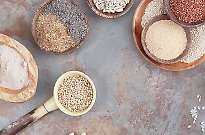
Understanding food intolerances

Not just a food fad
Navigating the somewhat ambiguous world of food intolerances can be a daunting and isolating journey. But there are innumerable positive experiences involved, with social understanding and acceptance ever increasing and the numbers of those with a food intolerance ever growing, writes Christina Bulbrook.
“Excuse me, just how intolerant are you?” The occupants of the table stare wide-eyed at the waiter.
“I mean, are you going to have an attack if you ingest dairy?” he ploughs on, oblivious to the glares he is receiving.
“Are you going to put dairy in my food if I say no?” the woman throws back.
The waiter looks horrified, mumbles something and shuffles back to hide behind the swinging door of the kitchen.
He is not alone in misunderstanding the nature of a food intolerance. In fact, many sufferers of food intolerances are still learning the ropes themselves.
Although food intolerances are on the rise across Australia and most of the population is becoming increasingly accustomed to and accommodating of their existence, there is still grey area surrounding the sometimes fuzzy line between allergy and intolerance.
FACE FACTS
In reality, the line between allergy and intolerance is not fuzzy at all. Simply put, a food intolerance is the body’s inability to digest certain ingredients, according to the NSW Food Authority, April 2013. It is not a food allergy, which involves an immune system reaction to particular foods. Nor is a food intolerance a moral decision to avoid certain foods or part of the latest weight-loss fad or an aversion to certain ingredients. It is just the body expressing its incapacity to digest certain chemicals or foods in a variety of ways. Symptoms can include – but are not restricted to – bowel or stomach upsets, bloating, migraines, hives or wheezing.
Georgie Rist, accredited practising dietitian and spokesperson for the Dietitians Association of Australia, says there is a tendency for food intolerances to be hereditary. Alternatively, “sometimes food intolerance only affects a person after a sudden change in diet or after an illness,” she says. According to the NSW Food Authority, most recent research indicates that up to 25 per cent of the population believe they have a form of food intolerance.
The most common foods or chemicals that produce adverse reactions of varying severity include dairy products, food additives like MSG, citrus fruits, and products containing histamines like red wine (Raising Children Network, Australian Parenting Website, 2014). Other common culprits include gluten, soy, fructose and salicylates.
THE TRICKY BUSINESS
Living with one or more of these intolerances is not without its challenges.
If the diagnosis takes place later in life, the greatest challenges can be coming to terms with, then actually initiating, change in our lifestyles and our diets, the two of which are often inseparable.
“We are creatures of habit,” says Rist. “Food is subjective and very personal, so being told that your favourite food is causing you migraines three times a week can sometimes be hard to swallow.”
Another common issue faced by those living with food intolerances is dining out. In this age of fast-food tendencies and time-poor people, eating out is often a more attractive option than preparing a meal. Plus it is an enjoyable way of socialising. But it becomes problematic in a group when one person needs to avoid certain ingredients, especially if the group intends to order a handful of dishes to share. It can be extremely socially isolating and many people with food intolerances dislike others fussing over them. In the end, if it becomes too difficult or awkward, some sufferers prefer to avoid eating out altogether.
Gemma, a lawyer from Sydney, touches on another difficulty she faces with waiters, and even with friends, when eating out. “In recent years, people hear I can’t eat gluten and think it’s a lifestyle choice or weight-loss plan,” she says. “This can be very frustrating. I would never choose to be gluten-free. Contrary to popular opinion, it’s not actually healthier.”
Having been diagnosed with coeliac disease over a decade ago, she comments on how the lack of understanding at that time made life difficult as well.
“When I was first diagnosed as a coeliac, nobody even knew what gluten was,” she says. Coeliac disease, is in fact, neither an allergy nor an intolerance, but rather an auto-immune disease and is caused by an immune reaction to gluten entering the body. But it is often associated with the development of a lactose intolerance, as was the case for Gemma who, at the time of her diagnosis in her early 20s, had already been on a gluten-free diet for the best part of a decade, before which she had endured years of chronic digestive issues. “[I spent] years going to the GP, complaining of digestive problems and constantly being told it was a bug or something I ate,” she recalls.
THE POSITIVE LENS
Thankfully, those times are largely behind us, as attitudes are changing and medical understanding is constantly developing and improving. Although it can seem disappointing or even devastating to be diagnosed with a food intolerance, it is not all bad news. In fact, a multitude of positive lifestyle changes can stem from a diagnosis of food intolerance.
The most common – and perhaps the most obvious positive transformation – is the remarkable difference it makes to the digestive system and overall wellbeing of a sufferer when the culprit food is identified and eliminated. Gemma recalls the effect of removing gluten from her diet. “It made my life so much easier,” she remembers. “I didn’t have to plan my life around my digestive system anymore!”
Although foods friendly to those with an intolerance or allergy are becoming exponentially accessible for purchase and restaurants are growing increasingly accommodating of dietary requirements, it can still be overwhelming upon being diagnosed to know where to start. To ensure you remain on friendly terms with food, it is strongly recommended to seek the guidance of an accredited practising dietitian. “Seeing a dietitian is essential during the investigation process and particularly after diagnosis of food intolerances to provide individual assessment and dietary advice,’ Rist advises.
“Make food labels your friend,” she suggests. “Self-diagnosis can be dangerous and lead to unnecessary food restrictions and a number of health issues such as nutrient deficiencies, mood changes, [or] fatigue.” Seeing a dietitian who specialises in food intolerances can support your journey to ensure you still eat a healthy and varied diet while avoiding your trigger foods.
TRAVEL TOLERANCE
Remaining on top of food intolerances and maintaining the renewed sense of wellbeing that comes from ridding the body of trigger foods can become tricky when travelling abroad.
Rist reiterates the importance of preparation by researching ahead of time, taking safe foods and communicating as best you can. “Read blogs and use social media to discover other people’s experiences,” she suggests. “Learn the local phrases and language to communicate your food intolerances when ordering food or reading food labels.”
When asked about travelling with her coeliac disease and lactose intolerance, Gemma particularly recalls her highly favourable experience in Italy. “Before I went, I downloaded the Italian Coeliac Society app and learnt how to say “I am coeliac” and “I cannot eat gluten” in Italian.” She agrees with Rist about carrying food with you when possible. “I always made sure I had gluten-free bread on me when we went out in case I couldn’t find anything.” Her overall advice, echoing Rist, underlines the importance of preliminary research before departing.
Although it may seem daunting or awkward explaining your intolerances to others, whether at home or further afield, the world is becoming increasingly well versed in the language of dietary requirements, with Australia among the best informed.
Ultimately, it is a question of wellbeing. The difficult decision to eliminate a particular trigger food – even a favoured food – from your diet can only result in positive change. And you are never alone in your journey of navigating through symptoms, food labels and restaurant menus. Be sure to communicate; talk to your family, your friends, your waiters, chefs, GP and dietitian. Help is never far away. NH
Christina Bulbrook is a freelance writer specialising in health and sociological writing. She has written for various publications and literary journals. She has lived with various food intolerances herself for a number of years.


